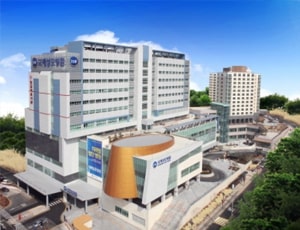The average cost of CABG - Redo in Seoul approximately starts from USD 37000
Treatment cost

International St. Mary's Hospital located in Seoul, South Korea is accredited by JCI. Also listed below are some of the most prominent infrastructural details:

Awaxy called plaque hets deposited in good amounts in the coronary arteries of the heart, they supply oxygen to the heart. With time the plaque starts hardening and eventually ruptures and breaks open. This plaque interferes with blood flow as arteries grow narrow at that region. A blood clot develops when the plaque ruptures open on the surface. The artery gets blocked if the blood clot developed is very large. This can be the cause of heart attack in a later stage becoming the cause of a life risk.
Coronary artery bypass surgery aims at improving the general blood circulation to the heart. A healthy artery or vein is taken the body and is grafted or connected to the blocked coronary artery for bypassing. This artery or vein goes around the blocked portion of the coronary artery and establishes a new path for the blood to flow to the heart thus reducing the chance of a heart attack. In one surgery surgeons can bypass multiple coronary arteries. Severe blockages can be treated with this procedure.
The other alternatives for CABG can be balloon surgery or angioplasty which is a less invasive technique but then your cardiologist is the best person to decide which of the surgeries is best suited
The patients are transferred out of ICU right after the day of the surgery. Heart rhythm disturbances are found in 25% of patients within a period of 3 or 4 days after the surgery. They are temporary atrial fibrillations that are associated with surgical trauma. They respond well to standard
Ask your healthcare adviser for the best multiple options and choose the one that meets your expectations
The average cost of CABG - Redo in Seoul starts from $37000. In Seoul, CABG - Redo is conducted across many multispecialty hospitals.
Different hospitals have different pricing policy when it comes to the cost of CABG - Redo in Seoul. The CABG - Redo package cost usually includes all the expenses related to pre and post surgery expenses of the patient. Typically, the package cost of CABG - Redo in Seoul includes the expenses related to the surgeon's fee, anesthesia, hospital, meals, nursing and ICU stay. Extended hospital stay, complications after the surgery or new diagnosis may affect the overall cost of CABG - Redo in Seoul.
There are many hospitals across the country that offer CABG - Redo to international patients. For quick reference, the following are some of the leading hospitals for CABG - Redo in Seoul:
The recovery of the patient many vary, depending on several factors. However, on an average, patient is supposed to stay for about 21 days in the country after discharge. This duration of stay is recommended to complete all the necessary follow-ups and control tests to ensure that the surgery was successful.
There are certain expenses additional to the CABG - Redo cost that the patient may have to pay for. These charges may vary from 40 USD per person.
After the CABG - Redo surgery takes place, the average duration of stay at the hospital is about 7 Days. This time frame is important for the patient to recover properly and feel comfortable after the surgery. With the help of several tests, it is determined that the patient is doing fine after the surgery and is okay to be discharged.
There are around 1 Hospitals hospitals in Seoul that offer CABG - Redo to international patients. These hospitals have the required infrastructure and a decided CABG - Redo unit where renal failure patients can be treated. Also, these hospitals follow the necessary guidelines as required by the medical associations for the treatment of CABG - Redo patients.
Some of the most sought after doctors for CABG - Redo in Seoul are: